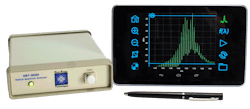New Ridge Technologies NRT-8000 Compact OSA
Traditional optical spectrum analyzers (OSAs) are based on free-space optics and a tunable diffraction grading and often come with a price tag of $30,000 to $50,000, New Ridge says. With the NRT-8000 Compact OSA, the company sought to provide a small, portable OSA at a fraction of the cost. The list price is $9,000, making it feasible for an OSA to be used for dedicated monitoring applications and not shared across a lab, New Ridge asserts, explaining that a new NRT-8000 costs about the same as refurbishing and recalibrating a 15-year-old OSA. The size of the NRT-8000 is 1.73x5.78x7.88 inches, and the instrument weighs less than 2 lbs.
OSA control is offered via a Windows-based UP and .dlls for lab automation. A client interface allows users to remotely log into the NRT-8000 via an IP connection from anywhere.
Click here to return to the 2015 Lightwave Innovation Awards page


